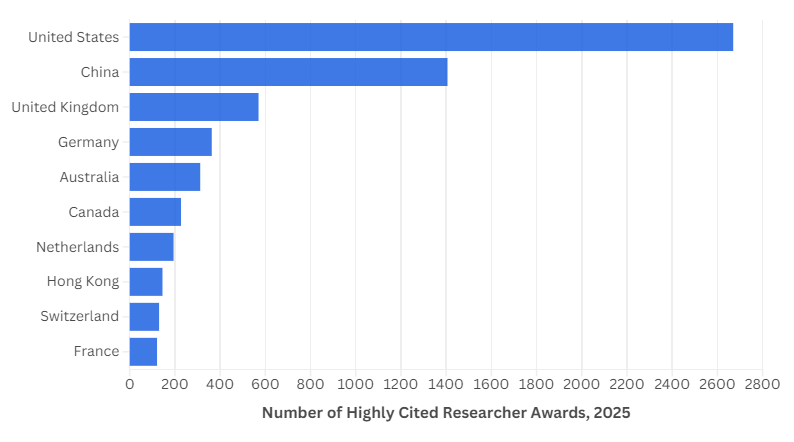
The analysis behind this year’s Highly Cited Researchers list, released today by indexing giant Clarivate, includes several tweaks aimed at reducing attempts to game the metric and excluding researchers who engage in questionable publication practices.
Those changes include removing highly cited papers from the calculations authored by researchers excluded from last year’s list for integrity issues. The company also applied specific removal criteria — including excessive self-citation rates, papers retracted for integrity concerns, and prolific publication rates — more comprehensively this year. In past years, the company had done so manually for particular geographic areas or disciplines.
“We’re trying to make sure that the indicators are valid and reliable, which means we have to include these kinds of filters or screens and quantitative tests that indicate some kind of quality, qualitative character,” David Pendlebury, head of research analysis at the Institute for Scientific Information at Clarivate, told Retraction Watch.
The changes have also made it possible for mathematics to return as a category in the 2025 list. Clarivate stopped including the discipline in 2023 after the field’s relatively small number of papers, as well as evidence of citation manipulation, led to the company to drop the discipline as a category.
“What we saw over time was the dominance of a particular topic taking over all of mathematics, and that had all the markings of people gaming as well,” Pendlebury said. “That is why we decided to suppress the field of mathematics for two years and find a solution which allowed the truly influential people to resurface, so that they could be selected and highlighted. And that’s fortunately what we have this year.”
Clarivate excludes retracted papers from its initial pool of data used to calculate the Highly Cited Researchers list. In 2022, the company started using the Retraction Watch Database for some of the qualitative components of its analysis, including checking the names on its preliminary list against the database for evidence of misconduct.
“The innovation of this year is that all these criteria are now more comprehensively and consistently applied across all researchers,” said Dmytro Filchenko, Clarivate’s senior director of research and analysis.
Those criteria include anomalous levels of self citation or group citation; authorship of papers retracted for integrity issues; community reports of breaches in research integrity; and prolific authorship, according to documentation for the Highly Cited Researchers list. The company also excludes authors with an anomalous ratio of reviews to articles.
The changes led to 2,400 researchers being excluded this year because of integrity concerns, 432 of which were for hyper-prolific authorship. The total number excluded has increased over the years, from 500 in 2022 to 1,000 in 2023 and over 2,000 last year.
“These improvements led to the fact that more space for new researchers whose work may have been overshadowed previously is now available,” Filchenko said. “Usually our retention rate — so, meaning the highly cited researchers from the previous year who appear again in the new year — is around 70 percent. This year, it’s 60 percent.”
This year’s list includes 7,131 Highly Cited Researcher designations to 6,868 people, with some being recognized in more than one field. The United States is home to the largest share of the researchers, 2,670 or 37 percent. That marks a 1 percentage point increase from 2024 and follows several years of declines.
China has the second highest number of researchers, with 1,406 or nearly 20 percent of the total highly cited list.
The list for mathematics includes 65 researchers. As part of reintroducing math to the list, Clarivate consulted with mathematician Domingo Docampo of the University of Vigo in Spain. Docampo and colleagues developed an algorithm independent of Clarivate’s methods to evaluate citations based on the quality of the citing reference. “We asked him to run his algorithm on the people who we nominated this year in mathematics,” Filchenko said. “Both algorithms were in agreement.”
As in years past, the list starts from the top 1 percent of papers in each field and publication year, and includes articles and reviews published in the last 11 years. In addition to removing retracted papers, Clarivate also excludes those with more than 30 authors or with group authorship. The company develops a preliminary list from the authors of those papers, applying the filters for research integrity concerns, publication practices, and so on, to arrive at the final list.
Just as authorship can be abused, so can citation practices.
“It’s amazing for me to see over the years, over these decades, how important these measures have become,” Pendlebury said. He reflected how Eugene Garfield, the founder of the Institute for Scientific Information, warned against overreliance on metrics. “He actually asked in one article, ‘Is the tail now wagging the dog?’ So he was always concerned and always cognizant of how these data can be misused.”
“We have had to deal with what is a rising tide of pollution in the literature, generally gaming of the publication citation metrics,” Pendlebury continued. “We have to deal and guard against gaming of these indicators, because we want them to be robust and reliable. That’s why we’ve had to include all these screens and filters.”
Like Retraction Watch? You can make a tax-deductible contribution to support our work, follow us on X or Bluesky, like us on Facebook, follow us on LinkedIn, add us to your RSS reader, or subscribe to our daily digest. If you find a retraction that’s not in our database, you can let us know here. For comments or feedback, email us at [email protected].